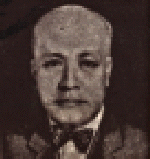 Rafael Palma
Rafael Palma(1874-1939)
Orator, statesman, scholar, educator, and writer. Born in Tondo, Manila, on October 24, 1874. He was involved in the propaganda campaign against the Spaniards. He cofounded with Gen. Antonio Luna the revolutionary newspaper, La Independencia. Later, he also founded El Nuevo Dia, Cebu’s first daily. Died in Manila on May 24, 1939.
Rafael Palma
From Wikipedia, the free encyclopedia
| Rafael Palma | |
|---|---|
 | |
| Born | October 24, 1874 Manila |
| Died | May 24, 1939 Manila |
| Occupation | Senator |
Honors
- A building at the University of the Philippines, Diliman was named after him (Palma Hall). Today, the UP College of Social Sciences and Philosophy resides in this building.
- University of Bohol, a private school in Tagbilaran City, Bohol, Philippines was named after Rafael Palma College in 1946 until it was changed into University of Bohol.
- There are many schools in the country which are named after Rafael Palma, like Rafael Palma Elementary School City of Makati and Rafael Palma Elementary School, Zobel Roxas Street, Manila, Metro Manila, Philippines.
- Barangay Rafael Palma Real Estate Property which is situated in Diffun Town, Quirino Province, Cagayan Valley Region, the Philippines.
Books
Palma wrote a biography of Dr. Jose P. Rizal which Justice Roman Ozaeta translated to English with the “The Pride of the Malay Race.[1]“- The Woman and the Right to Vote by Rafael Palma[2].
- The new mentality by Rafael Palma , 1929.
Juan Luna
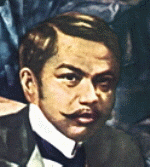 Juan Luna
Juan Luna(1857-1899)
A genius of the brush and a patriot of the highest order. Creator of the world-famous painting, SPOLARIUM, which was awarded the gold medal in the Exposicion Nacional de Bellas Artes in Madrid in 1884. It is also known as the greatest painting of all times. Born in Badoc, Ilocos, Norte, on October 23, 1857. He was closely associated with the Reform Movement, together with Rizal, Lopez-Jaena, Ponce, etc. He died in Hongkong on December 7, 1899.
Early life
Born in the town of Badoc, Ilocos Norte in the northern Philippines, Luna was the third among the seven children of Don Joaquin Luna de San Pedro y Posada and Doña Laureana Novicio y Ancheta. In 1861, the Luna family moved to Manila and he went to Ateneo Municipal de Manila where he obtained his Bachelor of Arts degree. He excelled in painting and drawing, and was influenced by his brother, Manuel Luna, who, according to Filipino patriot José Rizal, was a better painter than Juan himself.Luna enrolled at Escuela Nautica (Academia Naval) and became a sailor. He took drawing lessons under the illustrious painting teacher Lorenzo Guerrero of Ermita, Manila. He also enrolled in the Academy of Fine Arts (Academia de Dibujo y Pintura) in Manila where he was influenced and taught how to draw by the Spanish artist Agustin Saez. Unfortunately, Luna’s vigorous brush strokes displeased his teacher and Luna was discharged from the Academy. However, Guerrero was impressed by his skill and urged Luna to travel to Spain to further pursue his studies.
In 1877 Manuel and Juan Luna traveled to Europe, where Manuel studied music and Juan painting. Juan entered the Escuela de Bellas Artes de San Fernando, where he befriended the painter Don Alejo Vera. Luna was discontented with the style of teaching in school and decided that it would be much better to work with Vera. Vera brought him to Rome for some of his commissions, and Luna was exposed to the art of the Renaissance painters. It was in 1878 when his artistic talents was established with the opening of the first art exposition in Madrid which was called the Exposición Nacional de Bellas Artes (National Demonstration of Beautiful Arts). From then on, Luna became engrossed in painting and produced a collection of paintings that he exhibited in the 1881 Exposition.
His La Muerta de Cleopatra (The Death of Cleopatra) won him a silver medal and came in second place. Luna’s growing reputation as an artist led to a pensionado (pension) scholarship at 600 pesos annually through the Ayuntamiento of Manila. The condition was that he was obliged to develop a painting which captured the essence of Philippine history which would then become the Ayuntamiento’s property.

Spoliarium, painted by Juan Luna (oil on canvas) circa 1884.
[edit] Career
In 1883 Luna started the painting demanded of him by the Ayuntamiento. In May 1884, he shipped the large canvas of the Spoliarium to Madrid for the year’s Exposición Nacional de Bellas Artes. He was the first recipient of the three gold medals awarded in the exhibition and Luna gained recognition among the connoisseurs and art critics present. On June 25, 1884, Filipino and Spanish nobles organized an event celebrating Luna’s win in the exhibition. That evening, Rizal prepared a speech for his friend, addressing the two significant things of his art work, which included the glorification of genius and the grandeur of his artistic skills.Luna developed a friendly relationship with the King of Spain and was later commissioned by the Spanish Senate to paint a large canvas which was called the La Batalla de Lepanto (The Battle of Lepanto). He moved to Paris in 1885 where he opened his own studio and befriended Felix Resurreccion Hidalgo. A year after, he finished the piece El Pacto de Sangre (The Blood Compact) in accordance with the agreement he had with the Ayuntamiento of Manila. Depicted in this piece was the blood compact ceremony between the native chieftain Datu Sikatuna and the Spanish conquistador Miguel López de Legazpi. It is displayed in the Malacañang Palace. He also sent two other paintings in addition to the one required; the second canvas sent to Manila was a portrait of Don Miguel López de Legazpi reconstructed by Luna from his recollection of López de Legazpi’s portrait he saw in the hall of the Cabildo, and the third was of Governor-general Ramón Blanco y Erenas.
In 1887, Luna once again traveled back to Spain to enter in that year’s Exposition two of his pieces, the La Batalla de Lepanto and Rendición de Granada (Surrender of Granada), which both won in the exhibition. He celebrated his triumph with his friends in Madrid with Graciano Lopez-Jaena delivered Luna a congratulatory speech. Luna’s paintings are generally described as being vigorous and dramatic. With its elements of Romanticism, his style shows the influence of Delacroix, Rembrandt, and Daumier.
On December 8, 1886, Luna married Maria de la Paz Pardo de Tavera a sister of his friend Felix and Trinidad Pardo de Tavera. The couple traveled to Venice and Rome and settled in Paris. They had one son, whom they named Andrés, and a daughter who died in infancy. Luna was fond of painting his wife. Unfortunately, an occurrence tragically ended their married life. The jealous Luna frequently accused Paz of having an affair with a certain Monsieur Dussaq. Finally in a fit of jealousy, he killed his wife and mother-in-law and wounded his brother-in-law, Felix, on September 23, 1892. He was arrested and murder charges were filed against him.
Luna was acquitted of charges on February 8, 1893. He was ordered to pay the Pardo de Taveras a sum of one thousand six hundred fifty one francs and eighty three cents, and an additional twenty five francs for postage, in addition to the interest of damages. Five days later, Luna went to Madrid with his brother, Antonio Luna, and his son, Andrés.
[edit] Final years
In 1891 Luna moved back to the Philippines and traveled to Japan in 1896, returning during the Philippine Revolution of the Cry of Balintawak. Unfortunately, on September 16, 1896, he and his brother Antonio Luna were arrested by Spanish authorities for being involved with the Katipunan rebel army. Despite his imprisonment, Luna was still able to produce a work of art which he gave to a priest’s visit. He was pardoned by the Spanish courts on May 27, 1897 and was released from prison and he traveled back to Spain. In 1898, he was appointed by the executive board of the Philippine revolutionary government as a member of the Paris delegation which was working for the diplomatic recognition of the República Filipina (Philippine Republic). In 1899, upon the signing of the Treaty of Paris (1898), Luna was named a member of the delegation to Washington to press for the recognition of the Philippine government.He traveled back to the Philippines in December 1899 upon hearing of the death of his brother Antonio who was in Hong Kong in exile. On December 7, 1899, Luna suffered a heart attack and died there. His remains were buried in Hong Kong and in 1920 were exhumed and kept in Andrés Luna’s house, to be later transferred to a niche at the Crypt Chapel of San Agustin in the Philippines. Five years later, Juan would be reinstated as a world renowned artist and Peuple et Rois, his last major work, was acclaimed the best entry to the Universal Exposition of St. Louis in the United States. Unfortunately some of his paintings were destroyed by fire in World War II.
[edit] See also
[edit] Publications
- Manuel, Arsenio. Dictionary of Philippine Biography, Volume II. Manila: Regal Printing Company, 1970.
- Ocampo, Ambeth R. “Juan Luna’s Works.” Philippine Daily Inquirer, 24 October 2007.
- Sevilla, José N. Sa Langit ng Bayang Pilipinas. Mga Dakilang Pilpino o Ang Kaibigan ng mga Nag-aaral. Manila: Limbagan nina Sevilla at mga kapatid at Kn., 1922.
[edit] External links
Felipe Agoncillo (1859-1941)
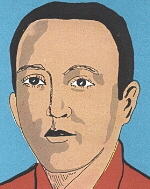 Felipe Agoncillo
Felipe Agoncillo(1859-1941)
Outstanding diplomat of the Philippine revolution. Born in Taal, Batangas, on May 26, 1859. Gen. Emilio Aguinaldo appointed him as Minister Plenipotentiary to the peace conference in Washington and Paris. Died on September 29, 1941, at the Manila Doctor’s Hospital.
Felipe Agoncillo (May 26, 1859 – September 29, 1941) was the Filipino lawyer representative to the negotiations in Paris that led to the Treaty of Paris (1898), ending the Spanish–American War and achieving him the title of “outstanding first Filipino diplomat.”[1]
As a family friend and adviser of General Emilio Aguinaldo[2] and General Antonio Luna[3] during the critical times of the revolution, Agoncillo has been active in participating during that era especially when he presided the Hong Kong Junta—a group of Filipino exiles who met to plan for future steps in achieving independence.[4] His greatest contribution of the Philippine history was when he was assigned to negotiate foreign countries to secure the independence of the country considered as the most important assignment given by a General.
Outstanding student
Agoncillo was born on May 26, 1859 in Taal, Batangas to Ramon Agoncillo and Gregoria Encarnacion.At an early age, his parents already noticed his brilliant mind. He enrolled at the Ateneo Municipal de Manila where he was a consistent honor high school student and later transferred to the Universidad de Santo Tomás where he obtained his law degree in 1879 with an excellent grade. He was granted a Licentiate in Jurisprudence with the highest honors.
He returned to Taal to manage his family’s properties after a year studying in Manila because his parents had both died.
Marriage
Agoncillo was already a judge and at the age of 30 when he was married to Marcela Mariño, a daughter of a reputed family in the same town. Six daughters were born to them: Lorenza (Enchang), Gregoria (Goring), Eugenia (Nene), Marcela (Celing)—named after her mother because they thought she will be their last child, Adela, who died at the age of three and the youngest Maria (Maring), who was their last child to survive and died on July 6, 1995.Charity
While in Taal, Agoncillo continued his legal services and gave charity to poor and oppressed Filipinos. He was so generous that he posted an inscription outside his office: “Free legal services to the poor anytime.”[6]Having heard by the parish priest of his activities and for preaching patriotic ideas, he was accused as anti patriotic, anti religious and was described as filibustero or subversive. He was later recommended to the governor-general for deportation.
Exile to Hong Kong
Forewarned by the plans of the governor-general, he sailed directly to Yokohama, Japan but briefly stayed and went to Hong Kong where he joined other Filipino exiles who found asylum when the revolution broke out in 1896. They temporarily sojourned at Morrison Hill Road in Wanchai and later became a refuge for exiled Filipino patriots.When the signing of the Pact of Biak-na-Bato concluded, Gen. Aguinaldo joined to them. They initiated meetings in the Agoncillo residence on the months of April and March 1898 and Gen. Luna was one in the attendance.[7]
Diplomacy
After the signing of the truce, Agoncillo spearheaded the Central Revolutionary Committee and organized the propaganda office for General Aguinaldo’s revolutionary government.The Philippine Revolutionary Government commissioned Agoncillo as Minister Plenipotentiary to negotiate treaties with foreign governments. Agoncillo and Jose “Sixto” Lopez was sent to Washington, D.C., United States[8] to lobby foreign entities that Filipinos are well civilized people and capable of maintaining stable government[5] and to secure recognition of Philippine independence but US President William McKinley did not receive them. To gather sympathy to the Philippine cause, they addressed the American Episcopalian bishops.
After being ignored by the US president, Agoncillo proceeded to Paris, France to present the Philippine cause at the peace conference convened between Spain and the US, where a meeting was to be held to discuss Cuba and the Philippines. Agoncillo tried to submit a memorandum but again failed. The people behind the meeting did not want to have any official dealings with him.[5] On December 10, 1898, the treaty was successfully been signed.
Subsequently, Agoncillo’s diplomatic activity incurred sum of money that he had used up all his savings going from one country to another presenting the case of the Philippines that he had even sacrificed his wife’s jewelry.
Agoncillo’s protest
Two days after the signing of the Treaty of Paris, Agoncillo returned to the United States and endeavored to block ratification of the treaty by the US. Although this was signed by the commissioners, it was not yet approved by the Senate of the United States. He filed a State memorandum to express that Filipinos must be recognized by the United States.[9] He presented a formal protest which was called Memorial to the Senate to the president and delegates of the Spanish-American Commission saying:If the Spaniards have not been able to transfer to the Americans the rights which they did not possess; if the latter have not militarily conquered positions in the Philippines; if the occupation of Manila was a resultant fact, prepared by the Filipinos; if the international officials and representatives of the Republic of the United States of America offered to recognize the independence and sovereignty of the Philippines, solicited and accepted their alliance, how can they now constitute themselves as arbiters of the control, administration and future government of the Philippine Islands?Agoncillo’s conclusion about the treaty was that it was not binding on the Philippine government.[6] In the memorandum, he clearly stated the reasons why Spain had no right to transfer the Philippines to the United States and that when the treaty was signed, Spain no longer held the Filipinos.
If the Treaty of Paris there had simply been declared the withdrawal and abandonment by the Spaniards of their domination –if they had such –over Filipino territory, if America, on accepting peace, had signed the Treaty, without prejudice to the rights of the Philippines, and with a view to coming to a subsequent settlement with the existing Filipino National Government, thus recognizing the sovereignty of the latter, their alliance and the carrying out of their promises of honor to the said Filipinos, no protest against their action would have been made. But in view of the terms of the Article III of the Protocol, the attitude of the American Commissioners, and the imperative necessity of safeguarding the national rights of my country, I take this protest, for the before-mentioned reasons but with the proper legal reservations, against the action taken and the resolutions passed by the Peace Commissioners at Paris and in the Treaty signed by them.[10]
At that time, many Americans were also against the treaty, so they established the Anti-Imperialist League which opposed making the Philippines a colony of the United States. Afterwards, on February 4, 1899, the Philippine–American War began; this turned on approval of the treaty of Paris.
Post Philippine–American War
On August 29, 1900, he met with Gustave Moynier, an original member of the Committee of Five and ICRC President. Agoncillo sought recognition of the Filipino Red Cross Society as well as the application of the First Geneva Convention during the Philippine–American War.[11]Return to Manila
When hostilities ended between Filipinos and Americans, he returned to Hong Kong and rejoined the exiled junta. Later, on July 15, 1901, after American rule was firmly established in Manila,[7] he went back to the Philippines as a poor man and lived in his house in Malate, Manila together with his family.Continuing service
While in Manila, he resumed his law practice and other business. He took the bar exam in 1905 and passed with a perfect score of 100 percent, an achievement which has remained unmatched until today. His examination papers have been preserved in the Filipiniana section of the Philippine Library and Museum.In 1907, he was elected as the Batangas representative and represented that town, among others, in the Philippine Assembly.[12] He was once a defense of El Renacimiento whose editors were charged with libel by Dean C. Worcester. De Agoncillo was appointed as Secretary of Interior in 1923 during the administration of Governor General Leonard Wood and fought for the Filipinazation of the government service.[6]
Death
Agoncillo died on September 29, 1941 in Manila Doctor’s Hospital, Manila.Words of wisdom
Agoncillo shared the following words of wisdom:[13]- Kailangan ang katapatan upang magkaunawaan. (Truth is needed to attain understanding.)
- Kailangan ng mga sawimpalad ang pagkalinga ng mga higit na mapalad. (The less fortunate need care from the more fortunate.)
- Kayamanan, oras, at kahit na buhay ay maiaalay ng taong nagmamahal sa bayan. (A person who loves his or her country can offer to it wealth, time or even life itself.
nuffnang_bid = “640ed586b20798b3b9e95fd994fa8a05″;
Fernando Ma. Guerrero
(1873-1890)
Musician, journalist, politician, and lawyer. Considered the greatest lyric poet in Spanish. Born in Ermita, Manila, on May 30, 1873. When the revolution broke out, General Antonio Luna invited him to join the editorial staff of La Independencia, the organ of the revolution. Thus, he fought for the Filipino cause with his pen. Died in Manila June 12, 1929.
(1873-1890)
Musician, journalist, politician, and lawyer. Considered the greatest lyric poet in Spanish. Born in Ermita, Manila, on May 30, 1873. When the revolution broke out, General Antonio Luna invited him to join the editorial staff of La Independencia, the organ of the revolution. Thus, he fought for the Filipino cause with his pen. Died in Manila June 12, 1929.
Fernando María Guerrero
From Wikipedia, the free encyclopedia
Biography
Guerrero was born to a noble family and began writing literatures at a young age. He excelled in the facility of language and obtained his Bachelor of Arts degree from the Ateneo Municipal and the Bachelor of Laws degree at the University of Santo Tomas and wrote journals during the years 1898 to 1900. He became a lawyer and he taught criminology and forensic oratory. He served as chairman of the board of study at the law school La Jurisprudencia (The Jurisprudence). He also became a councilor, secretary of the senate and secretary of the Philippine Independence commission. He was also a director of the Academia de Leyes (Academy of Regulation). Apart from Spanish, Guerrero spoke Latin and Greek and he was an editor of El Renacimiento (The Renaissance), La Vanguardia (The Outer works) and La Opinion (The Opinion). He was a member of the First Philippine Assembly, the Academia Filipina (Philippine Academy) and also became a leader of the Municipal Board of Manila. He was also a correspondent to the association Real Española de Madrid (Spanish Royal of Madrid) and his book of Spanish poems, Crisalidas, was published in 1914 by the Enciclopedia Filipinas (Philippine Encyclopedia). His other poems written after 1914 appeared in a compilation called Aves y Flores (Hail and Flowers). Guerrero died on June 12, 1929, coinciding with that year’s anniversary of the República Filipina (Philippine Republic). A school in Paco, Manila was named after him in his honor.[1]Poetry
A 1913 poem written by Guerrero:Original in Spanish
| “ | A Hispania Oh, noble Hispania! es para ti mi canción, canción que viene de lejos como eco de antiguo amor, temblorosa, palpitante y olorosa a tradición para abrir sus alas cándidas bajo el oro de aquel sol que nos metiste en el alma con el fuego de tu voz y a cuya lumbre, montando, clavileños de ilusión, mi raza adoró la gloria del bello idioma español, que parlan aún los Quijotes de esta malaya región, donde quieren nuevos Sanchos, que parlemos en sajón.[2] | ” |
English translation
| “ | To Spain O, Noble Spain! This song is for thee A song that comes from afar Like an old love Trembling, palpitating Fragrant with tradition To open thy candid wings Under the goldness of thy sun Which we’ve received into our souls With the fire of thy voice In whose brightness ride The keys of hope, My race adored the glory Of the beauty of the Spanish tongue That is spoken even by the Quijotes From this Malay region, Where New Sanchos are longed for Instead of speaking in Saxon tongue. | ” |
Gregoria de Jesus
Gregoria de Jesus
(1875-1943)
One of the brave and patriotic women who played a heroic role in the Philippine revolution. Born in Kalookan City, on May 9, 1875. Wife of Andres Bonifacio and Lakambini of the Katipunan. She actually fought alongside her husband during the revolution, aside from being the custodian of the Katipunan documents. She organized the Katipunan’s Women Chapter. She died on March 15, 1943.
Gregoria de Jesus (15 May 1875 – 15 March 1943), also known as Aling Oriang,[1] was the founder and vice-president of the women‘s chapter of the Katipunan of the Philippines.[2] She was also the custodian of the documents and seal of the Katipunan.[1] She married Andrés Bonifacio, the supremo of the Katipunan, and played a major role in the Philippine Revolution.[1] She is regarded as “The Mother of the Philippine Revolution” by Filipinos.[3] She has one son from Andrés Bonifacio and five children from Julio Nakpil.
In March 1893, she married Andrés Bonifacio at the Catholic Church of Binondo. A week later, they were married again in the presence of the Katipuneros, who did not approve of their marriage in a Catholic church.[4] On the evening of the same day, the women’s chapter of the Katipunan was formed, and she was appointed its vice-president and the custodian of the Katipunan documents. She was designated the code name “Lakambini” (Tagalog for goddess or Muse) and swore to remain loyal to the Katipunan’s holy purposes.[4][5] The Spanish police usually came unannounced, and Gregoria used to gather all the documents and drive her car all night and return only when it is safe.
A year later, she returned to her family’s house, because she was pregnant. She gave birth to their only son, who she christened Andrés, after her husband.[4] Two months later, during the Holy Week of 1896, Gregoria and her husband returned to Manila to find their house destroyed by a fire. The couple were forced to live in friends’ and family houses, but had to move quickly from house to house. A few months later, their child, Andrés, died of small pox.[5]
On 19 August 1896, the Katipunan was exposed and its secrets were revealed by Teodoro Patino, a dissatisfied Katipunero.[5] The Spanish forces reacted quickly to halt the revolution. Many Filipinos were arrested, jailed, and shot, but Andrés and Gregoria were hiding. The Spanish government was able to tighten its surveillance over the Katipunan. The remaining Katipuneros gathered and planned an attack on a Spanish gunpowder storehouse. With an army of almost 800 men, the Katipuneros were successful in their first attack, and were encouraged to advance to Manila, but the Katipunan powers were defeated by the Spanish forces, and hundreds of the Katipuneros were killed and captured.[5] Furthermore, an inner conflict between Andrés and Aguinaldo, another leader of the Katipunan, had weakened them. On 8 May 1897, Andrés was captured by Aguinaldo’s officers, and was sentenced to death.[4][5] Gregoria, during the capture, was raped by some Katipuneros who supported Aguinaldo, with the aim of shaming Andrés.[4]
Julio Nakpil, a commander of the Katipunan troops in Northern Philippines. The two fell in love with each other, and were married in a Catholic church on 10 December 1898 in Manila.[4] After the end of the Philippine Revolution and after peace was restored in the Philippines, Gregoria lived with her husband and eight children in a house with a well-known Filipino philanthropist, Dr. Ariston Bautista, and his wife, Petrona Nakpil. The doctor took good care of her and her children and helped raise them and educate them.
Gregoria de Jesus died in 1943 during the Japanese occupation of the Philippines.
(1875-1943)
One of the brave and patriotic women who played a heroic role in the Philippine revolution. Born in Kalookan City, on May 9, 1875. Wife of Andres Bonifacio and Lakambini of the Katipunan. She actually fought alongside her husband during the revolution, aside from being the custodian of the Katipunan documents. She organized the Katipunan’s Women Chapter. She died on March 15, 1943.
Gregoria de Jesus
From Wikipedia, the free encyclopedia
| Gregoria de Jesus | |
|---|---|
 Portrait of Gregoria de Jesus | |
| Born | 15 May 1875(1875-05-15) Caloocan, Philippines |
| Died | 15 March 1943 (aged 67) Manila, Philippines |
| Spouse(s) | Andrés Bonifacio (1893 – 1897) Julio Nakpil (1898 – 1943) |
[edit] Early life
Gregoria de Jesus was born in the city of Caloocan, in the Filipino province of Rizal to a Catholic middle-class family.[4] Her father, Nicolas de Jesus, was a carpenter who later served as a gobernadorcillo.[1] As a young girl, she was an exceptional student and a silver medal recipient in an examination organized by the governor general and parish priest. When she became a secondary school student, she was induced by her parents to stay home and look after her younger sister and the family’s farm, since both of her older brothers moved to Manila to continue their education.[1][4][edit] Philippine Revolution
Main article: Philippine Revolution
When Gregoria de Jesus was only 18 years old, Andrés Bonifacio fell in love with her and wanted to marry her.[5] He revealed his intentions to her parents, but her father refused and was against their marriage because Andrés was a Freemason. After almost six months, she had fallen in love with him. She revealed that to her father and asked for his approval on their marriage and the father agreed.[4]In March 1893, she married Andrés Bonifacio at the Catholic Church of Binondo. A week later, they were married again in the presence of the Katipuneros, who did not approve of their marriage in a Catholic church.[4] On the evening of the same day, the women’s chapter of the Katipunan was formed, and she was appointed its vice-president and the custodian of the Katipunan documents. She was designated the code name “Lakambini” (Tagalog for goddess or Muse) and swore to remain loyal to the Katipunan’s holy purposes.[4][5] The Spanish police usually came unannounced, and Gregoria used to gather all the documents and drive her car all night and return only when it is safe.
A year later, she returned to her family’s house, because she was pregnant. She gave birth to their only son, who she christened Andrés, after her husband.[4] Two months later, during the Holy Week of 1896, Gregoria and her husband returned to Manila to find their house destroyed by a fire. The couple were forced to live in friends’ and family houses, but had to move quickly from house to house. A few months later, their child, Andrés, died of small pox.[5]
On 19 August 1896, the Katipunan was exposed and its secrets were revealed by Teodoro Patino, a dissatisfied Katipunero.[5] The Spanish forces reacted quickly to halt the revolution. Many Filipinos were arrested, jailed, and shot, but Andrés and Gregoria were hiding. The Spanish government was able to tighten its surveillance over the Katipunan. The remaining Katipuneros gathered and planned an attack on a Spanish gunpowder storehouse. With an army of almost 800 men, the Katipuneros were successful in their first attack, and were encouraged to advance to Manila, but the Katipunan powers were defeated by the Spanish forces, and hundreds of the Katipuneros were killed and captured.[5] Furthermore, an inner conflict between Andrés and Aguinaldo, another leader of the Katipunan, had weakened them. On 8 May 1897, Andrés was captured by Aguinaldo’s officers, and was sentenced to death.[4][5] Gregoria, during the capture, was raped by some Katipuneros who supported Aguinaldo, with the aim of shaming Andrés.[4]
Julio Nakpil, a commander of the Katipunan troops in Northern Philippines. The two fell in love with each other, and were married in a Catholic church on 10 December 1898 in Manila.[4] After the end of the Philippine Revolution and after peace was restored in the Philippines, Gregoria lived with her husband and eight children in a house with a well-known Filipino philanthropist, Dr. Ariston Bautista, and his wife, Petrona Nakpil. The doctor took good care of her and her children and helped raise them and educate them.
Gregoria de Jesus died in 1943 during the Japanese occupation of the Philippines.
Mariano Ponce
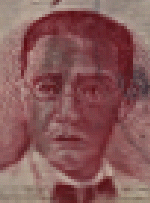 Mariano Ponce
Mariano Ponce(1863-1918)
Researcher, historian, bibliographer, propagandist, diplomat, physician, folklorist, and an outstanding reformist. Born in Baliwag, Bulacan, on March 23, 1863. While in Spain, he joined the propaganda movement and became one of the initiators of La Solidaridad, later becoming its managing editor. Died in HongKong on May 23, 1918.
Mariano Ponce
From Wikipedia, the free encyclopedia
Mariano Ponce (March 23, 1863 – May 23, 1918), was a Filipino physician who was one of the leaders of the Propaganda Movement, that founded the Philippine Revolution.Ponce was born in Baliwag, Bulacan where he completed his primary education. He later enrolled at the Colegio de San Juan de Letran and took up medicine at the University of Santo Tomas. In 1881, he traveled to Spain to continue his medical studies at the Unversidad Central de Madrid.
While he was studying in Spain, he joined Marcelo del Pilar, Graciano López Jaena and José Rizal in the Propaganda Movement which espoused Filipino representation in the Spanish Cortes and reforms in the Spanish colonial authorities of the Philippines. He wrote in the propaganda publication La Solidaridad (The Solidarity).
Ponce was imprisoned when the revolution began on August 1896 but was later released. Fearing another arrest, he fled to France and later went to Hong Kong where he joined a group of Filipinos who served as the international front of the Philippine revolution.
In 1898, Emilio Aguinaldo chose him to represent the First Philippine Republic. He traveled to Japan to seek aid and purchase weapons. With the help of a Filipino-Japanese named José Ramos Ishikawa, Ponce purchased weapons and munition for the revolution. But the shipment did not reach the Philippines due to a typhoon off the coast of Formosa.
Mariano returned to Manila with his wife, a Japanese girl named Okiyo Udanwara.[1] In 1909, he was made director of “El Renacimiento” (The Renaissance). He also joined the “Naciónalista Partido” (National Party) and established “El Ideal” (The Perfect), the party’s official organization. Ponce later ran for a seat in the Philippine Assembly and was elected assemblyman for the second district of Bulacan. Ponce wrote his memoirs, “Cartas Sobre La Revolución” (Letters on the Revolution), he died in the Civil Hospital in Hong Kong, on May 23, 1918. His remains are now in the Cementerio del Norte, Manila.
Panday Pira
 Panday Pira
Panday Pira(1483-1576)
First Filipino cannon-maker. He forged the cannons which Rajah Sulayman used in defending the Muslim Kingdom of Manila against the Spanish invaders. Born in one of the islands in Southern Philippines in 1483. He died in 1576.
Panday Pira
From Wikipedia, the free encyclopedia
Panday Pira (1488-1576) was a Moro blacksmith[1] who is acknowledged as “The First Filipino Cannon-maker”.[2] His name literally translates as “Blacksmith Pira”, panday being the Filipino word for “blacksmith”.Panday Pira was a native of the southern islands of the Philippines. He migrated to Manila in 1508 and established a foundry on the northern bank of the Pasig River. Rajah Sulayman commissioned Panday Pira to cast the cannon that were mounted on the palisades surrounding his kingdom. In 1570, Spanish forces under the command of Martin de Goiti captured Manila and took these artillery pieces as war booty, presenting them to Miguel López de Legazpi, the first Spanish Governor-General of the Philippines.
Legazpi eventually established a permanent Spanish settlement in Manila on May 19, 1571 and on June 3 of the same year, Rajah Sulayman waged the Battle of Bankusay Channel to re-capture his kingdom from the Spaniards. Rajah Sulayman failed in this and perished in the battle. Panday Pira then fled to Pampanga where he attempted to begin a new life as a blacksmith forging farm implements. He was, however, summoned by Legazpi back to Manila and put to work forging cannons for the Spaniards. He established his foundry in what is now Santa Ana. Santiago de Vera, the sixth Governor-General, commissioned him to cast cannon for the defenses of a fortress he built, the fortress of Nuestra Señora de Guia (Spanish, “Our Lady of Guidance”), now called Intramuros.[3] To the Spaniards, Panday Pira was known as Pandapira,[4] and they exempted him from paying tribute and forced labor.
In 1576, Panday Pira died at the age of 88. His death was a great loss to the Spaniards who had to petition the King of Spain for a blacksmith to take his place. It was not until 1584, that a Spanish blacksmith from Mexico arrived.
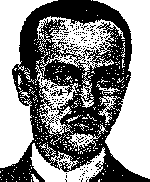 Graciano Lopez-Jaena
Graciano Lopez-Jaena(1856-1896)
Founder and first editor of the newspaper La Solidaridad, which became the vehicle of expression for Filipino propaganda in Spain. Together wtih Jose Rizal and Marcelo H. Del Pilar, he undertook propaganda campaigns in Spain. Born in Jaro, Iloilo, on December 18, 1856. He died on January 20, 1896, in Barcelona, Spain.
Biography
López Jaena was born in Jaro, Iloilo to Placido López and María Jacoba Jaena. His parents were poor, as his mother was a seamstress and his father a general repairman. At the age of six, López Jaena was placed under the care of Friar Francisco Jayme who raised him.His parents sent López Jaena to the Seminario de San Vicente Ferrer in Jaro which had been opened under the administration of Governor General Carlos María de la Torre. While studying at a seminary institution, López Jaena served as a secretary to an uncle named Claudio López who was the honorary vice consul of Portugal in Iloilo. His ambition of becoming a physician, convinced his parents that this was the better course of action. López Jaena sought enrollment at the University of Santo Tomas but was denied admission because the required Bachelor of Arts degree was not offered at the seminary in Jaro. However he was appointed to the San Juan de Dios Hospital as an apprentice. Unfortunately, due to financial problems, his parents could not afford to keep him in Manila. He returned to Iloilo and practiced medicine in communities.
During this period, his visits with the poor and the common people began to stir feelings about the injustices that were common. At the age of 18 he had the audacity to write the story “Fray Botod” which depicted a fat and lecherous priest. Botod’s false piety “always had the Virgin and God on his lips no matter how unjust and underhanded his acts are.” This naturally incurred the fury of the Friars who knew that the story depicted them. Although it was not published a copy circulated in the region but the Friars could not prove that López Jaena was the author. However he got into trouble for refusing to testify that certain prisoners died of natural causes when it was obvious that they had died at the hands of the mayor of Pototan. López Jaena continued to agitate for justice and finally went to Spain when threats were made on his life.
López Jaena sailed for Spain. There he was to become a leading literary and oratorical spokesman for the Philippine reformal issues. Philippine historians regard López Jaena, along with Marcelo H. del Pilar and José P. Rizal, as the triumvirate of Filipino propagandists. Of these three Ilustrados (Knowledgeable), López Jaena was the first to arrive and may have founded the genesis of the Propaganda movement.
López Jaena pursued his medical studies at the school of medicine at the University of Valencia but did not finish the course. Once Rizal approached Lopéz Jaena for not finishing his medical studies. Graciano replied, “On the shoulders of slaves should not rest a doctor’s cape.” Rizal countermanded, “The shoulders do not honor the doctor’s cape, but the doctor’s cape honors the shoulders.”
He then moved to the field of journalism. Losing interest in politics and academic life, he soon enjoyed his life in Barcelona and Madrid. However, his friends would forgive him these indiscretions due to his appeal with words and oratory. Mariano Ponce who was another of the Filipino propagandists in Spain observed, “… a deafening ovation followed the close of the peroration, the ladies waved their kerchiefs wildly, and the men applauded frantically as they stood up from their seats in order to embrace the speaker.”
Rizal noted, “His great love is politics and literature. I do not know for sure whether he loves politics in order to deliver speeches or he loves literature to be a politician.”
In addition he is remembered for his literary contributions to the propaganda movement. López Jaena founded the fortnightly newspaper, La Solidaridad. When the publication office moved from Barcelona to Madrid, the editorship was succeeded to Marcelo H. del Pilar.
López Jaena died of tuberculosis on January 20, 1896, two years short of his 40th birthday. His death was followed on July 4th by Marcelo H. del Pilar and on December 30th of José Rizal by firing squad, thus ending the great triumvirate of propagandists. He died in poverty just shy of his fortieth birthday and two and a half years before the declaration of independence from Spain by Emilio Aguinaldo.
Legacy
The Graciano Lopez Jaena Chapter, Order of DeMolay, sponsored by the Free and Accepted Masons, was founded in 1965 in Jaro, Iloilo city. The Order of DeMolay is a youth fraternal organization where young men are taught to become better individuals. The chapter was named after Graciano Lopez Jaena, the first and foremost Freemason hailing from Jaro.Melchora Aquino
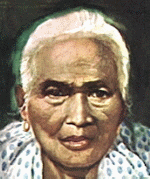 Melchora Aquino
Melchora Aquino(1812-1919)
B etter known as Tandang Sora. Born in Banlat, Kalookan City, on January 6, 1812. She helped the Katipuneros under the leadership of Andres Bonifacio by providing them food, shelter, and other material goods. She is recognized as the Grand Woman of the revolution and the Mother of Balintawak. She died on March 12, 1919.
Early life and marriage
Melchora Aquino was born on January 6, 1812 in Caloocan. Melchora, daughter of a peasant couple, Juan and Valentina Aquino, never attended school. However, she was apparently literate at an early age and talented as a singer. She performed at local events as well as at Mass for her Church.She was married to Fulgencio Ramos, a cabeza de barrio (village chief), and bore six children. Ramos died when their youngest child was seven and she was left as a single parent for their children.
[edit] Involvement in the revolution
In her native country, Aquino operated a store, which became a refuge for the sick and wounded revolutionaries. She fed, gave medical attention to and encouraged the revolutionaries with motherly advice and prayers. Secret meetings of the Katipuneros (revolutionaries) were also held at her house. Thus she earned the name, “Mother of the Katipunan” or revolution. When the Spaniards learned about her activities and her knowledge to the whereabouts of the Katipuneros, she was asked where there were hiding but refused to conquerors steadily. She was then arrested by the Spanish Guardia Civil and was deported to the Mariana Islands.After the United States took control of the Philippines in 1898, Aquino, like other exiles, returned to Philippines until her death on March 2, 1919 at the age of 107. Her remains lie in her own backyard (now as Himlayang Pilipino Memorial Park, Quezon City).











Your post is very great.I read this post. It’s very helpful. You can check more about Adapalene and Benzoyl Peroxide manufacturer here
ReplyDelete